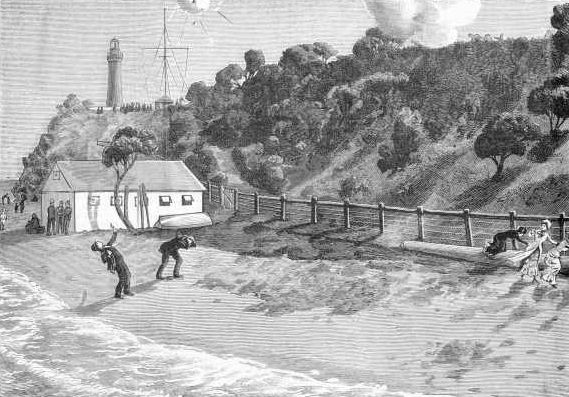- Myth 1
- It's a pity that Cerberus was filled with concrete.
- Myth 2
- The Pope's Eye Annulus was built to protect Cerberus.
- Myth 3
- Cerberus blew the roof off a St Kilda chemist shop in 1878.
- Myth 4
- Cerberus was not allowed to fire its guns near shore.
- Myth 5
- Because of the resulting damage Cerberus could not fire a Broadside.
- Myth 6
- Cerberus could not venture outside the Heads.
- Myth 7
- The Flying deck was only meant to be temporary.
- Myth 8
- Cerberus never fired a shot in anger.
- Myth 9
- There was no likelihood of the Russians attacking Melbourne.
- Myth 10
- Cerberus steamed to Westernport Bay in 1921.
- Myth 11
- Cerberus did not Practise Enough.
- Myth 12
- Cerberus was a slow ship.
- Myth 13
- The Stress of Supervising the Fitting Out of Cerberus Killed Captain Norman.
- Myth 14
- The Cerberus crew fired a shell that killed a civilian.
- Myth 15
- Cerberus Crew Saves a Cabby.
- Myth 15
- Cerberus was stripped of her armour when scrapped.
- Myth 16
- Cerberus moved when scuttled & hence settled in the wrong position.
- Myth 17
- Victoria's Navy was not called the Victorian Navy.
- Myth 18
- The Guns on Cerberus were hardly ever fired.
Not true. A number of people who have dived in Cerberus assure me that there is no concrete inside. With all that heavy armour why would you need concrete to make the ship sink?
It is likely that this myth originated with the publication of G. C. Ingleton's book WATCHDOGS Infernal & Imperial in 1934. This otherwise excellent description of the eight warships named Cerberus incorrectly stated on page 30 that "She was filled with concrete, and towed across the bay.....".
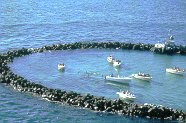

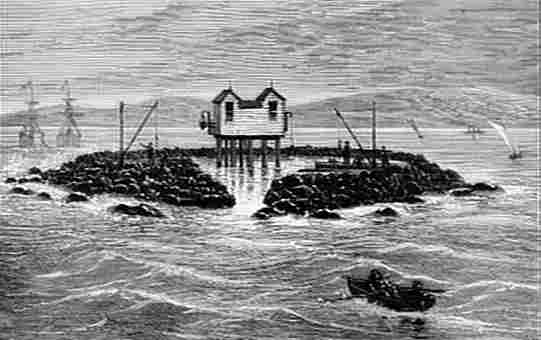
Not true. The Pope's Eye annulus is simply a half finished fort.
The photo of present day Pope's Eye (left) looks remarkably similar to the sketch of the South Channel Fort under construction (right).
The construction of the Pope's Eye fort ceased when new guns with greater range were installed at the Swan Island fort.
When Captain Panter was asked about positioning his ship near the Pope's Eye he stated. 1
4308. Supposing instead of the Cerberus being at the point you propose over here-[pointing to diagram]-where the Cerberus would take up her position, that is somewhere in the vicinity of the Pope's Eye?
"No, my position would be under weigh [sic], simply trying to close with the vessel, and I would begin as near the rip as I could. I would work within those three points trying to drive her to the forts, or the forts driving her to me. I would not be stationary."
This myth appears to have originated from a discussion of the need to complete the Pope's Eye fort in 1886.
"It is thought that a few of these (Harbour Trust) barges placed within the annulus of the new fort would enable heavy artillery to be mounted. This temporary battery would serve a useful purpose in case of emergency." Argus November 26 1886
It was further reported in the Argus newspaper that it was probable the Minister of Defence will ask Parliament for £20,000 to complete the Pope's Eye fort. The article continued that some naval authorities "...have doubted its necessity, seeing that strong forts had already been provided at Point Nepean & Franklin on the one side & Queenscliff & Swan Island on the other. ...It has been, however, suggested that the stonework should remain as it is, & that in warfare one of the hopper barges - the Fawkner or Batman - might be taken into the annulus, & in that way the stonework be transformed into a fort as the vessel could fire through an embrasure & be protected by the stone walls." Argus April 21 1890
Note: Pope's Eye was named after a Mr. Pope and not the Roman Catholic Pontiff.
Not true. The source of this myth was an incident in November 1877 where a shell fired from HMVS Nelson landed outside the St Kilda railway station. Apparently the shell, which would have been spinning clockwise, (as it had been fired from a rifled gun) ricocheted to the left instead of the right and hence landed ashore. No explanation could be offered as to why the shell behaved so unpredictably. There was no mention of a chemist shop in the original detailed newspaper reports of 1877.
This Cerberus myth seems to have originated in an article on St. Kilda in the Argus newspaper on 9 January 1932 where a brief reference was made to "....if we look closely at the northern wall we may see the mark made by a cannon ball fired by the Cerberus while at target practice off Williamstown." This was corrected by M.L. of St. Kilda in the Argus on January 23 when, demonstrating a good knowledge of the incident, he pointed out that it was a shot from Nelson that was to blame.
Not true. It fired them everywhere. There appears to be no evidence to support this. During exercises in 1872 Cerberus fired 114 shots near Williamstown (100 with 30 lb, of powder, and 14 with 40 lb.) No complaints appeared in the newspapers of the day following what must have been an extremely noisy event. The only complaint discovered to date was made in a letter to the editor of The Argus newspaper on 19 October 1885. The writer complained about the noise made by heavy ordnance on ships firing near Brighton.
Not true. The guns were regularly fired as a broadside Cerberus certainly suffered damage when firing all guns at once. This was however normal for a warship with large calibre guns. The 1876 Battleship, HMS Inflexible, had a similar problem. In 1882 she fired eighty-eight 16 inch shells at the bombardment of Alexandria. The concussion from these shots rent her upperworks and smashed her boats.
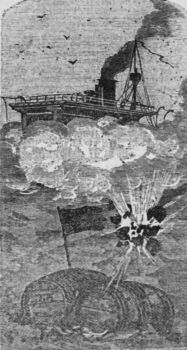
A Broadside from the Cerberus
The Australasian, April 1888
"The order was first given for the broadside firing on the port beam. A concentrated broadside from the Cerberus would have destructive effect upon any object it struck. There are two turrets, four 18-ton guns. Seventy pounds of powder are used in each charge, & the weight of the projectile is 400lb. The weight of metal discharged would therefore be 1,600lb, & if the shots struck in the same spot they would make an impression upon the most heavily armoured ironclad, whilst they would at once sink any vessel of ordinary calibre. The distance given for the first shot was 1,000 yards beyond the target; but the direction was good, & if a Russian ironclad had been there it would have received the whole weight of the charge, which, unless it was a vessel of great strength, would have disabled or sunk it. |
In more recent times before HMS Prince of Wales went into action it was routine to stow all breakable items as a precaution against damage from the firing of her own 15 inch guns. When the German battleship Bismarck fired its 15 inch guns at HMS Norfolk her own forward radar was put out of action.
In any case there were numerous occasions when it was recorded that Cerberus fired all four guns at once. The most recent occasion was during the 1904 Easter cruise.
Not true. It is assumed that as Cerberus was specially equipped for the trip out from Britain, with built up sides and sails, that she would have sunk without them. Magdala, the sister ship of Cerberus, made her delivery trip to Bombay without the built up sides. The near sister ship, Abyssinia, made the same trip without the built up sides and with no sails.
Presumably as Cerberus was the first of her class the authorities were unduly cautious. The poor handling on the delivery voyage is probably more a product of the extra weight of the built up sides, mast and sails plus the extra coal, than of the basic design. That Cerberus was carrying more weight above the waterline than below would not have been conducive to a smooth voyage.
It was 13 years after her arrival that Nelson went outside the Heads and Nelson was a line of battle fully rigged sailing ship. Basically the Victorian Navy existed for the protection of Pt. Phillip Bay and there was therefore no need to venture outside of it. In any case the legal authority of the Victorian Naval Forces ended 3½ miles from shore.
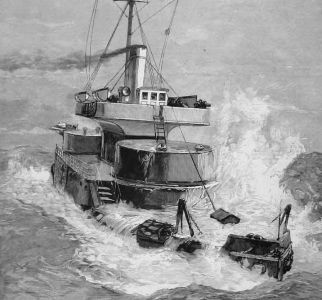 HMS Hecate, with the same dimensions as Cerberus, crossing the North Sea to Heligoland in 1884. Illustrated London News, 26 July 1884 |
That monitors could operate in the open seas is demonstrated by HMS Hecate (left) which crossed the North Sea to the then British posession of Heligoland, near Germany in 1884. |
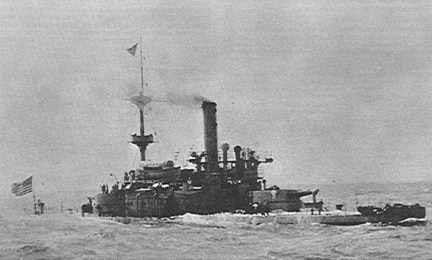
USS Monadnock crossing the Pacific. Imagine the ship on a rough day.
photo courtesy of US Navy Historical Center
Not true. The following quote has led many, including myself, to believe that the temporary iron deck referred to was the flying deck.
"She has had an additional iron deck placed on her, in order to enable her to be navigated to Australia, and she will also be masted. On her arrival in Melbourne she will have her temporary iron deck & bulwarks removed." The Mechanics Magazine, Nov. 19, 1869.
However a photo pointed out to us by Barrie Fisher & supplied by Mr. Vicary is interesting. (below)
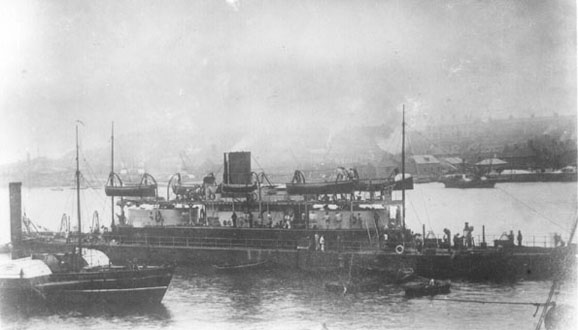
Photo courtesy of P. A. Vicary (Maritime Photo Agency)
It has been proven by Mark Griffin to be of Cerberus on the Tyne river. This demonstrates that the flying deck was fitted as part of the original construction. Bob Nicholls has suggested that the built up sides had a deck placed on top and that this is the temporary iron deck referred to above. This is further supported by an article in the Australasian that refers to plating being removed in Melbourne.
"The contractor for stripping the "Cerberus", Mr. James Deane, has been by no means idle and during the 11 days he has been at work the decks have been cleared of all bitts, timber-heads, iron capstan and windlass, riding bitts forward and aft, anchor-stoppers, hawee-pipes, and chocks, skylights, companions, combings, deck planks, iron bulwarks, iron topside plates, iron beams, and shelving, and the iron plating attached to the beams and permanent upper deck; these, together with all the cabin fittings fore and aft, put up for the voyage out, have been landed and removed away from the ship.The Australasian, May 20 1871.
Captain Panter's comments on the last Cerberus Easter cruise (albeit under tow) suggest that his cabin for the delivery voyage may have been in the temporary hamper section.
She was then built up with temporary bulwarks for the trip. Captain Panter, in speaking of his experiences, said:- "I remember that the top-hamper built on to her was only bolted on, & the water used to come underneath it & flood my cabin. I had to stand on a block of wood to dress myself, for that was the only dry spot in the cabin." The Argus, April 12 1909
It is worth noting that neither Cerberus's sister ship Magdala or the slightly smaller Abyssinia were fitted with raised sides and extra deck when they undertook their delivery voyages to India. Presumably as Cerberus was the first British Monitor, extra precautions were taken for such a long voyage.
True. A criticism often made of Cerberus is that she never fired a shot in anger. The thinking behind this is that somehow this is the fault of Cerberus.
That Cerberus never fired a shot in anger is absolutely true. Is Cerberus to blame for this? If she is then this would be the highest compliment that could be paid to a ship. The aim, as far as most people are concerned, for acquiring a warship is to deter aggression. If no war takes place then the best outcome has been achieved. If any ship was designed to counter aggression then Cerberus was the perfect example. She was not designed to steam across an ocean with the intention of conquering territory. She was purely "for the defence of Melbourne".
Not true. That only one war occurred between Britain & Russia in the nineteenth century is quite amazing. The Crimean War proved what could happen. On two other occasions (1877 and 1885) Russian and Britain came to the brink, troops were mobilised and fleets sent to troubled areas. Amazingly peace prevailed. Cerberus cannot take the credit for this but it would have been irresponsible not to take precautions in case the two world powers did come to blows a second time.
Russian Raiding Plans
Not true. Cerberus is said (at one stage by myself) to have steamed to and from Westernport Bay during 1921. In fact Cerberus did not steam anywhere after 1905 or possibly 1906 at the latest, when her second set of boilers was condemned.
The origin of the myth are entries in the logs of other ships stating that Cerberus was leaving Westernport for Port Phillip Bay. In fact these entries were referring to the South Australian gunboat Protector, which was renamed Cerberus on 1 April 1921. This is when Cerberus was renamed Platypus II.
Not true.
Commissioners - How frequently do you practice with the turret guns?
Captain Panter - In summer about once in six weeks; in winter, once a quarter.
Commissioners - Then the cost will always be an obstacle in the way of constant practice?
Captain Panter - I think so; but I think that is sufficient as regards the actual shot and shell practice once every six weeks, and that is more than is allowed in the Imperial ships.1
In 1898 when the second damaged gun was removed from the ship it was revealed that it had fired 207 rounds. Given that there were four guns, Cerberus was therefore firing an average of 32 rounds each year.
True. Cerberus is generally described as a slow ship only capable of steaming at speeds of about 7 knots. Although not a fast ship, Cerberus was nevertheless capable of exceeding 10 knots. Prior to her new boilers top speed appears to have been 11 knots where as with the cylindrical boilers she reached 12.4 knots in 1900. As the Herald stated on 12 April 1887 "One has to be aboard to appreciate the tremendous power of the engines, which force along that submerged mountain while the sea boils behind as if a volcanic eruption was proceeding."
Full DetailsNot true. It is often claimed that Captain Norman, who was sent to the UK to represent Victoria's interests in the fitting out of Cerberus, was killed by the stress involved in this role. The implication appears to be that this reflects badly on the ship.
He has lately been attacked by dropsy, in addition to his other maladies. Wellington Evening Post, 9 February 1870.
When the Victorian Agent General in London wrote to the Chief Secretary in Victoria informing him of Captain Norman's death he wrote "When Captain Norman arrived in England, I observed that he was seriously ill.....
No doubt that stress would not have helped Captain Norman's condition, but more relevant to causing his death was that he was "seriously ill" when he arrived in the UK."
Not true. A reminiscence published by Charles Dod in 19312 stated that a shell from one of the field guns from Cerberus exploded over Queenscliff beach wounding one man & killing another.
On 11 April 1882 the Age the Argus & three days later the Herald carried reports of a shell fired from a 40 pounder Armstrong gun exploding prematurely above Queenscliff beach. One passer by was wounded and another was so badly injured that he died the following day. The fatal shell was fired by a detachment of the Emerald-hill Artillery.
That the incident quoted by Charles Dod and the press reports in April 1882 are so similar including the name of the physician quoted by Charles Dod as Dr. Williams & by the Age as Surgeon-major Williams demonstrates that they are the same incident. Not only was the Victorian Navy not involved, but Cerberus was confined to Hobsons Bay for boiler repairs and dry-docking at the time.
Charles Dod's Account
On the second occasion*, the "Cerberus" had again anchored off Queenscliff. Several light field guns had been sent ashore & were being fired at floating targets in the Bay. There were a number of excursionists on the beach who had come from Melbourne by the midday steamer. Some of these were looking for seaweed, close to the Doctor's jetty when a shell, fired from one of the small guns on the Cliff exploded prematurely, just over their heads. Two men were struck by the flying fragments & one was so severely injured that he died a few hours afterwards when being conveyed to the Geelong Hospital. Dr. Williams, Health Officer, & the Surgeon of the "Cerberus" rendered first aid as quickly as possible, but the case was hopeless from the first. The other man was only slightly injured & was able to return to Melbourne by steamer. Considering the crowded state of the beach at the time of the explosion, it was remarkable that the casualties were so light.²
* the first occasion referred to was D.O.D.'s description of the Cerberus Torpedo Accident in 1881.
The Queenscliff Fatal Gun Accident — Explosion of a Shell
Illustrated Australian News, 19 April 1882 It is to be regretted that the Easter demonstration of the volunteers did not pass off without an accident, & our sketch artist gives an illustration of how an unfortunate man was nearly cut in two through the bursting of a shell fired from one of the Queenscliff batteries. It appears that on No. 5 gun of the 40-pounder battery fired the shell which burst before it had gone 150 yards, owing to the fuse being too short, & a portion of the fragments struck two young men who were walking on the beach directly under the gun, of these a Mr. Geo. Ross, a resident of Carlton, sustained the most serious injuries, having received a horrible lacerated wound on the right thigh, the upper portion of which was completely shattered. His companion, Mr. A. Daley, escaped with less serious hurts, being only slightly wounded in the thigh & hand. Mr. Ross was at his own request conveyed to Melbourne, his case being considered hopeless from the first, & was taken to the Melbourne hospital, where he expired on the following day. Mr. Daley was able to return to his own residence, & is progressing favorably towards recovery. The unfortunate sufferers had been warned that they were in too close, yet neglected to remove to a place of greater safety; but it would appear as if there should have been better precautions taken by those in charge to prevent strangers coming within the reach of injury.
The Queenscliff Fatal Gun Accident — Explosion of a Shell - (From a sketch by an Eye Witness)
Not true.
In Melbourne - Biography of a City, W.H. Newnman writes"...in 1863 a cab and horse were swept down Swanston Street into the Yarra. The horse drowned but the cabby was rescued by sailors of Victoria's first warship, HMVS Cerberus, who were stationed as a rescue squad with a boat at Princes Bridge."
There are two minor errors in the above myth. Cerberus did not arrive in Victoria until 1871. Also both Victoria and Nelson preceeded Cerberus as Victorian warships. Most likely the cabby was rescued by sailors of Victoria's first warship, HMCS Victoria.
This myth again shows that as the ships of the Victorian Navy have been forgotten, stories about the navy's various ships are attributed to the one ship that has not been forgotten, Cerberus.
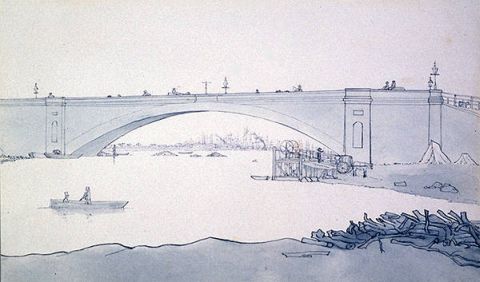
The Second Princes Bridge (Lennox’s Bridge)
When built, the longest single span bridge in the world.
attributed to Mary Morton Allport, Allport Library and Museum of Fine Arts
Not true.
In his book Port Phillip: Pilots and Defences3 Captain J. Noble writes that Cerberus was "stripped of lowmoor iron". R.J. Herd4 claims that the armour was either sold to the Victorian Railways and used to make rails or locomotives. Other sources claim that the armour was used to shield the nuclear reactor at Lucas Heights.
Having been on board Cerberus many times I can see no evidence of any armour having been removed apart from the small piece cut out of the aft turret. Apparently the cost of the oxy-acetelene gas & the labour used to cut the armour was greater that the armour's scrap value.
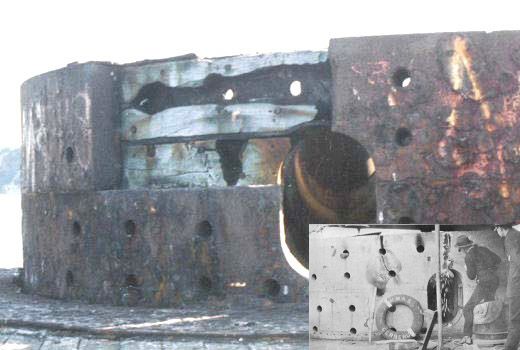
Main photo Peter DeGruchy, 1991. Inset photo from Williamstown Maritime Assoc.
Most likely not true. I can find no evidence to support this. Accounts published at the time carry no mention of movement. On the contrary they describe how Cerberus was made fast and then settled slowly.
"By 10 o'clock what was left of the Cerberus had been towed and coaxed by the tugs to within 400 yards of the jetty, where her bow was made fast to the existing breakwater, and the stern was slowly swung into position and secured to a temporary mooring. The operation had been timed for high water, when there is a depth of 15ft. on the bank selected for the breakwater, and it was estimated that the Cerberus was drawing nearly 14ft. Immediately the hull was made fast three seacocks were opened, and the flooding of the vessel began. Dingys put off from the jetty, and the harbour master's motor-boat took off a large crowd of excited small boys who swarmed over the decks and down below to watch the rising water. The Cerberus sank almost imperceptibly, going down slightly by the stern."
The Argus, 3 September 1926
The following report makes one wonder if the account of the scuttling of the submarine J7 just four years later, and in the next bay along the coast, may have become confused with the account of Cerberus being scuttled.
"J7 submarine. Sold to Morris and Watt of Melbourne and also ended her days behind the groyne at Sandringham yacht moorings. Bought by the Sandringham Yacht Club to form a breakwater, but in scuttling her she slewed around and sank parallel to the prevailing winds."
Shipwrecks of Port Phillip & the Rip
Not True
Yet another Cerberus myth is that Victoria's Navy was not actually known as the Victorian Navy but rather as the Victorian Naval Forces. This myth states that the term Victorian Navy was invented by people like myself wishing to glorify Victoria's naval forces. In fact there are many examples of the use of the term Victorian Navy both in the local and overseas press and in government documents. A good example is an item in the Victorian Government Gazette on 23 August 1895. This item clearly demonstrates how the two terms were used.
Towards the bottom of the item in the above mentioned Gazette, the following statement appears:-
"Alexander Harrow, Chief Engineer, Victorian Navy, being placed on the Retired List of the Victorian Naval Forces from and after 30th June 1895."
This sentence beautifully illustrates the use of the two terms.
The permanent naval force was known as the Victorian Navy. The part time force was known as the Victorian Naval Brigade5. Combined the Victorian Navy and the Victorian Naval Brigade were known as the Victorian Naval Forces. This also explains why the men mentioned in the Gazette have either V.N. or V.N.B. after their names.
That the same terminology was used in Britain is evidenced by an article, sourced from the War Office, in the London Gazette on 6 November 1900. As part of a list of those to whom Queen Victoria was awarding the Distinguished Service Order, the article listed Lieutenant William Jarvie Colquhoun, Victorian Navy.
Not True
When the second damaged gun was removed in 1898 it had fired 207 rounds.6
1 Royal Commission on the Volunteer Forces, Papers Presented to Parliament, 1875-6 Vol 3.
2 Early Memories of Queenscliff, D.O.D. Self Published, Geelong 1931.
3 Port Phillip: Pilots and Defences, Captain J. Noble, Melbourne, Hawthorn, 2nd edition, 1979, p. 100.
4 Battleship to Breakwater, R.J. Herd, Sandringham Historical Series, 1986.
5 The part time force was known as the Victorian Naval Brigade until 1870 when it became known as the Victorian Naval Reserve. In 1885 it again became known as the Victorian Naval Brigade. The Brigade/Reserve had two divisions, Williamstown and Port Melbourne. Prior to 1884 Port Melbourne was known as Sandridge.
6 The Weekly Times, 10 December 1898
